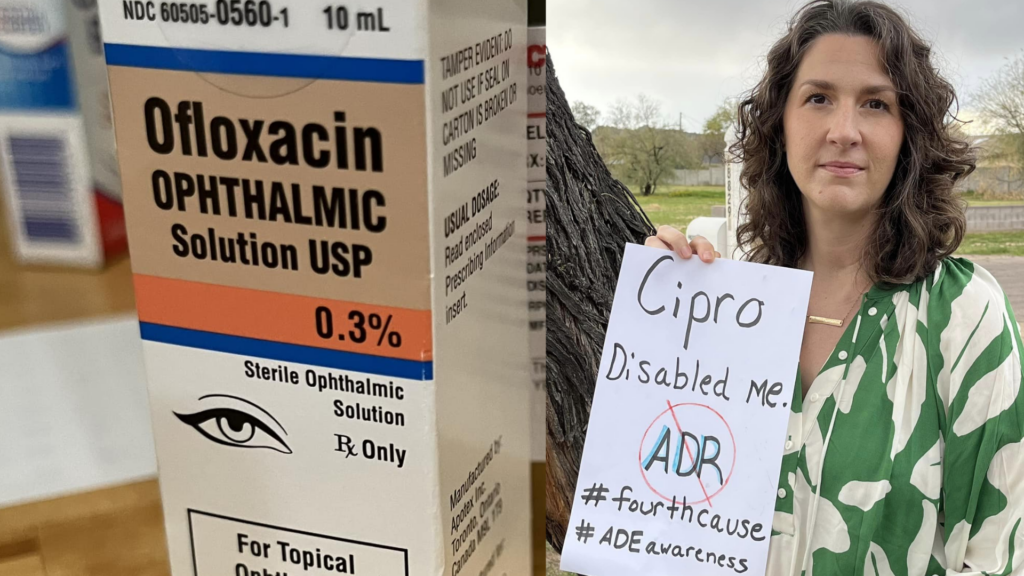In our pursuit of better health, we often rely on doctors to make critical decisions. Yet, there are instances when this trust is misplaced, leading to severe consequences for patients. One such case is that of Amy Moser, whose experience with fluoroquinolone antibiotics serves as a cautionary tale.
Understanding Fluoroquinolone’s Side Effects

The FDA acknowledges the necessity of caution with fluoroquinolones, considering their severe side effects. While the incidence of severe reactions is relatively low, ranging from 0.08% to 0.2%, the repercussions can be significant. These antibiotics should be reserved as a last resort due to their potential for severe adverse effects.
The Range of Risks

The FDA recognizes that sometimes this type of antibiotic is not needed. While only 0.08-0.2% of people see severe side effects, it should be the last line of defense as the side effects are severe. The Food and Drug Administration has these warnings because fluoroquinolones come with the risk of blindness due to tears in the retina, allowing fluid to build in your eye, as well as a significant risk of acute kidney failure.
Read More: Chemo Brain & 18 Long-Term Chemo Side Effects You Never Hear About
Other severe risks of using these antibiotics are:

- Ringing ears
- Burning pain in eyes and feet
- Heart palpitations
- Muscle spasms
- Uncontrollable shaking
- Musculoskeletal complications
- Hallucinations
- Depression
- Disfiguring rashes
Read More: Antibiotics Weakening Against Bloodstream Infections That Kill Newborns
Amy Moser’s Struggle

Amy Moser‘s ordeal epitomizes the devastating impact of fluoroquinolones. After being prescribed these antibiotics, she underwent numerous surgeries to address tendon, ligament, and muscle damage. Her experience illustrates the profound physical and psychological toll of these drugs, with no cure or relief in sight.
The Epidemic of Overprescription

The overprescription of fluoroquinolones reflects a broader issue in the medical community. Often, these potent antibiotics are prescribed unnecessarily or without adequate consideration of their risks. This practice underscores the need for more cautious prescribing habits among healthcare providers.
Read More: 39 Common Medications That Can Have Potentially Detrimental Side Effects
Identifying Problematic Antibiotics

Several fluoroquinolones, such as Cipro, Levaquin, and Avelox, should be avoided except as a last resort due to their potential for irreversible harm. Patients must engage in informed discussions with their doctors before accepting such prescriptions.
Unless it is a last resort, some of the fluoroquinolones still on the market to avoid are

- Cipro
- Floxin
- Oxaldin
- Tarivid
- Leflox
- Cravit
- Levaquin
- Tavanic
- Acflox Woodward
- Avelox
- Vigamox
Conclusion: Advocating for Informed Healthcare

While doctors play a crucial role in safeguarding our health, patients must actively engage in their care. Amy Moser’s story serves as a reminder to advocate for oneself and seek thorough explanations from healthcare providers. By fostering open dialogue and informed decision-making, we can mitigate the risks associated with potentially harmful medications.
Editor’s Note: This article was originally published in April 2017 and has since been updated.
Read More: Antibiotic use in babies linked to allergies, asthma and other conditions, study finds
Sources
- FDA Drug Safety Communication: FDA advises restricting fluoroquinolone antibiotic use for certain uncomplicated infections; warns about disabling side effects that can occur together. Fdagov. 2016. Available at: https://www.fda.gov/Drugs/DrugSafety/ucm500143.htm. Accessed April 13, 2017.
- Hall M, Finnoff J, Smith J. Musculoskeletal Complications of Fluoroquinolones: Guidelines and Precautions for Usage in the Athletic Population. PM&R. 2011;3(2):132-142. doi:10.1016/j.pmrj.2010.10.003.
- Brody J. Popular Antibiotics May Carry Serious Side Effects. Well. 2017. Available at: https://well.blogs.nytimes.com/2012/09/10/popular-antibiotics-may-carry-serious-side-effects/?_r=0. Accessed April 13, 2017.
- Stephenson A, Wu W, Cortes D, Rochon P. Tendon Injury and Fluoroquinolone Use: A Systematic Review. Drug Safety. 2013;36(9):709-721. doi:10.1007/s40264-013-0089-8.
This information is not intended to be a substitute for professional medical advice, diagnosis, or treatment and is for information only. Always seek the advice of your physician or another qualified health provider with any questions about your medical condition and/or current medication. Do not disregard professional medical advice or delay seeking advice or treatment because of something you have read here.

